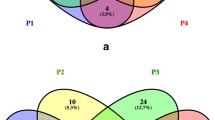Abstract
Over 100 bacteria from pulp and slime samples in a Canadian paper mill were identified by partial sequencing of their 16S rDNAs. Seventy-one percent of the isolates could be assigned to a bacterial genus with a high level of confidence. Another 12% exhibited at least 95% similarity within their 16S rDNA sequence with unidentified organisms that originate from warm or wet environments. Pseudomonas, Bacillus, and Pseudoxanthomonas isolates were represented at a relatively high proportion in both pulp and slime samples. This is the first time that Pseudoxanthomonas strains have been isolated from pulp and slime samples on a paper machine.
Similar content being viewed by others
References
Altschul SF, Madden TL , Schäffer AA , Zhang J, Zhang Z, Miller W, Lipman DJ (1997) Gapped BLAST and PSI-BLAST: a new generation of protein database search programs. Nucleic Acids Res 25:3389–3402
Appleyard GD, Clark EG (2002) Histologic and genotypic characterization of a novel Mycobacterium species found in three cats. J Clin Microbiol 40:2425–2430
Blanco MA, Negro C, Gaspar I, Tijero J (1996) Slime problems in the paper and board industry. Appl Microbiol Biotechnol 46:203–208
Brosius J, Palmer C, Kennedy PJ, Noller HF (1978) Complete nucleotide sequence of a 16S ribosomal RNA gene from Escherichia coli. Proc Natl Acad Sci USA 75:4801–4805
Evenleigh DE, Brewer D (1964) Ecological observations on the fungi and bacteria in slime accumulations in a paper mill. Can J Bot 42:35–43
Finkman W, Altendorf K, Stackebrandt E, Lipski A (2000) Characterization of N2O-producing Xanthomonas-like isolates from biofilters as Stenotrophomonas nitritireducens sp. nov., Luteimonas mephitis gen. nov., sp. nov. and Pseudoxanthomonas broegbernensis gen. nov., sp. nov. Int J Evol Syst Microbiol 50:273–282
Harju-Jeanty P, Väätänen P (1984) Detrimental micro-organisms in paper and cardboard mills. Paperi ja Puu 3:245–259
Hughes-van Kregten MC (1988) Slime flora of New Zealand paper mills. Appita 41:470–474
Kataoka M, Ueda K, Kudo T, Seki T, Yoshida T (1997) Application of the variable region in the 16S rDNA to create an index for rapid species identification in the genus Streptomyces. FEMS Microbiology Lett 151:249–255
Kolari M, Nuutinen J, Salkinoja-Salonen MS (2001) Mechanisms of biofilm formation in paper machine by Bacillus species: the role of Deinococcus geothermalis. J Ind Microbiol Biotechnol 27:343–351.1
Martin CH (1988) Identification and implications of troublesome slime-forming bacteria found in paper mill systems. In: Proc 1988 TAPPI Papermakers conference. TAPPI, Atlanta, Georgia, pp. 91–95
Merk S, Neubauer H, Meyer H, Greiser-Walker I (2001) Comparison of different methods for the isolation of Burkholderia cepacia DNA from pure cultures and waster water. Int J Hyg Environ Health 204:127–131
Oppong D, King VM, Zhou X, Bowen JA (2000) Cultural and biochemical diversity of pink-pigmented bacteria isolated from paper mill slimes. J Ind Microbiol Biotechnol 25:74–80
Pellegrin V, Juretschko S, Wagner M, Cottenceau G (1999) Morphological and biochemical properties of a Sphaerotilus sp. isolated from paper mill slimes. Appl Environ Microbiol 65:156–162
Safade TL (1988) Tackling the slime problem in a paper-mill. Pap Technol Ind September:280–285
Väisänen OM, Weber A, Bennasar A, Rainey FA, Busse H-J, Salkinoja-Salonen MS (1998) Microbial communities of printing paper machines. J Appl Microbiol 84:1069–1084
Väisänen OM, Nurmiaho-Lassila E-L , Marmo SA , Salkinoja-Salonen MS (1994) Structure and composition of biological slimes on paper and board machines. Appl Environ Microbiol 60:641–653
Väisänen OM, Mentus J, Salkinoja-Salonen MS (1991) Bacteria in food packaging paper and board. J Appl Bacteriol 71:130–133
Acknowledgements
This work was supported by a contract from Domtar Inc. We thank Julie Talbot, Daniel Vallée and Richard Gratton for valuable information on paper fabrication processes and Antonin Gauthier for a critical review of the manuscript.
Author information
Authors and Affiliations
Corresponding author
Rights and permissions
About this article
Cite this article
Desjardins, E., Beaulieu, C. Identification of bacteria contaminating pulp and a paper machine in a Canadian paper mill. J IND MICROBIOL BIOTECHNOL 30, 141–145 (2003). https://doi.org/10.1007/s10295-002-0017-x
Received:
Accepted:
Published:
Issue Date:
DOI: https://doi.org/10.1007/s10295-002-0017-x



